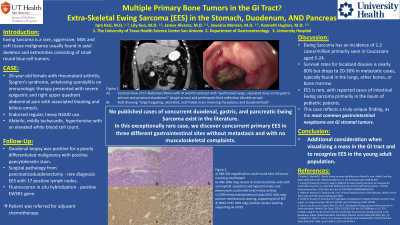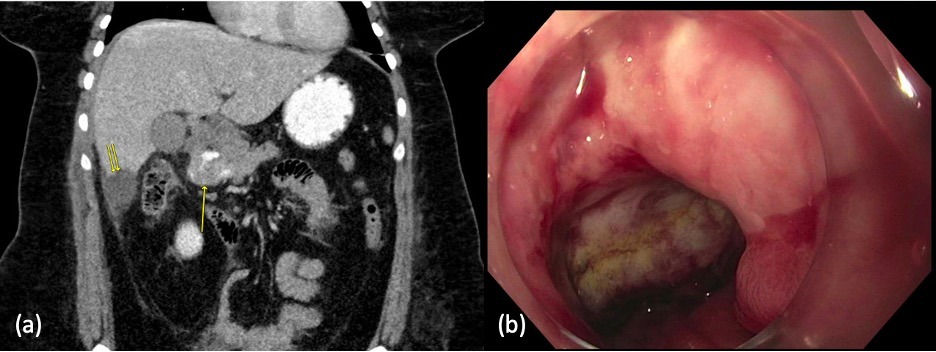Monday Poster Session
Category: Small Intestine
P2660 - Multiple Primary Bone Tumors in the GI Tract? Extra-Skeletal Ewing Sarcoma in the Stomach, Duodenum, and Pancreas
Monday, October 23, 2023
10:30 AM - 4:15 PM PT
Location: Exhibit Hall

Has Audio
.jpg)
Iqra Kazi, MD
UT Health San Antonio
San Antonio, TX
Presenting Author(s)
Iqra Kazi, MD1, Lily Kuo, MD2, James Alvarez, MD3, Jawairia Memon, MD2, Kenneth Hughes, MD2
1UT Health San Antonio, San Antonio, TX; 2University of Texas Health Science Center San Antonio, San Antonio, TX; 3University of Texas Health Science Center-San Antonio, San Antonio, TX
Introduction: Ewing Sarcoma is a musculoskeletal pediatric malignancy that consists of small round blue cell tumors. It primarily affects the axial skeleton and extremities and rarely has extraskeletal manifestations. There are a handful of case reports of primary intestinal Ewing Sarcoma. Here, we present a case of an adult female with Extra-skeletal Ewing Sarcoma (EES) of the GI tract.
Case Description/Methods: A 26-year-old female with RA, Sjogren’s syndrome, ankylosing spondylitis on immunologic therapy presented with severe epigastric and right upper quadrant abdominal pain with associated bloating and bilious emesis. She reported regular, heavy NSAID use. A CT abdomen/pelvis with IV contrast showed duodenal thickening, surrounding free air and perihepatic fluid suggestive of duodenal perforation with an oral contrasted study revealing a perforated, large, ulcerated mass involving the gastric antrum and proximal duodenum. EGD revealed a large fungating, ulcerated, and friable mass involving the pylorus and duodenal bulb. Following duodenal biopsy positive for a poorly differentiated malignancy with positive pancytokeratin stain, surgical pathology from pancreaticoduodenectomy revealed a rare diagnosis of extra-skeletal Ewing Sarcoma of the duodenum, stomach, and pancreas, with 17 positive lymph nodes. Fluorescence in situ hybridization had positive EWSR1 gene. She was referred for adjuvant chemotherapy.
Discussion: Ewing Sarcoma is a rare, aggressive, tumor usually found in bone and sometimes soft tissue with incidence of 1.2 cases/million primarily seen in Caucasians aged 5-24. Survival rates for localized disease is nearly 80% but drops to 20-30% in metastatic cases, typically found in the lungs, other bones, or bone marrow. EES is rare, with reported cases of intestinal Ewing sarcoma primarily in the ileum of pediatric patients. No published cases of concurrent duodenal, gastric, and pancreatic Ewing sarcoma exist in the literature. In this exceptionally rare case, we discover concurrent primary EES in three different gastrointestinal sites without metastasis and with no musculoskeletal complaints. This case reflects a truly unique finding, as the most common gastrointestinal neoplasms are GI stromal tumors. This case creates an additional consideration when visualizing a mass in the GI tract and to recognize EES in the young adult population. Future research is necessary to determine the etiology and pathophysiology of a primary bone tumor present in the GI tract.

Disclosures:
Iqra Kazi, MD1, Lily Kuo, MD2, James Alvarez, MD3, Jawairia Memon, MD2, Kenneth Hughes, MD2. P2660 - Multiple Primary Bone Tumors in the GI Tract? Extra-Skeletal Ewing Sarcoma in the Stomach, Duodenum, and Pancreas, ACG 2023 Annual Scientific Meeting Abstracts. Vancouver, BC, Canada: American College of Gastroenterology.
1UT Health San Antonio, San Antonio, TX; 2University of Texas Health Science Center San Antonio, San Antonio, TX; 3University of Texas Health Science Center-San Antonio, San Antonio, TX
Introduction: Ewing Sarcoma is a musculoskeletal pediatric malignancy that consists of small round blue cell tumors. It primarily affects the axial skeleton and extremities and rarely has extraskeletal manifestations. There are a handful of case reports of primary intestinal Ewing Sarcoma. Here, we present a case of an adult female with Extra-skeletal Ewing Sarcoma (EES) of the GI tract.
Case Description/Methods: A 26-year-old female with RA, Sjogren’s syndrome, ankylosing spondylitis on immunologic therapy presented with severe epigastric and right upper quadrant abdominal pain with associated bloating and bilious emesis. She reported regular, heavy NSAID use. A CT abdomen/pelvis with IV contrast showed duodenal thickening, surrounding free air and perihepatic fluid suggestive of duodenal perforation with an oral contrasted study revealing a perforated, large, ulcerated mass involving the gastric antrum and proximal duodenum. EGD revealed a large fungating, ulcerated, and friable mass involving the pylorus and duodenal bulb. Following duodenal biopsy positive for a poorly differentiated malignancy with positive pancytokeratin stain, surgical pathology from pancreaticoduodenectomy revealed a rare diagnosis of extra-skeletal Ewing Sarcoma of the duodenum, stomach, and pancreas, with 17 positive lymph nodes. Fluorescence in situ hybridization had positive EWSR1 gene. She was referred for adjuvant chemotherapy.
Discussion: Ewing Sarcoma is a rare, aggressive, tumor usually found in bone and sometimes soft tissue with incidence of 1.2 cases/million primarily seen in Caucasians aged 5-24. Survival rates for localized disease is nearly 80% but drops to 20-30% in metastatic cases, typically found in the lungs, other bones, or bone marrow. EES is rare, with reported cases of intestinal Ewing sarcoma primarily in the ileum of pediatric patients. No published cases of concurrent duodenal, gastric, and pancreatic Ewing sarcoma exist in the literature. In this exceptionally rare case, we discover concurrent primary EES in three different gastrointestinal sites without metastasis and with no musculoskeletal complaints. This case reflects a truly unique finding, as the most common gastrointestinal neoplasms are GI stromal tumors. This case creates an additional consideration when visualizing a mass in the GI tract and to recognize EES in the young adult population. Future research is necessary to determine the etiology and pathophysiology of a primary bone tumor present in the GI tract.

Figure: Figure 1
A) Coronal View of CT Abdomen/Pelvis with IV and PO contrast with “large, ulcerated mass in the gastric antrum and proximal duodenum” (single arrow) and perihepatic fluid collection (double arrow)
B) EGD showing large fungating, ulcerated, and friable mass involving the pylorus and duodenal bulb
A) Coronal View of CT Abdomen/Pelvis with IV and PO contrast with “large, ulcerated mass in the gastric antrum and proximal duodenum” (single arrow) and perihepatic fluid collection (double arrow)
B) EGD showing large fungating, ulcerated, and friable mass involving the pylorus and duodenal bulb
Disclosures:
Iqra Kazi indicated no relevant financial relationships.
Lily Kuo indicated no relevant financial relationships.
James Alvarez indicated no relevant financial relationships.
Jawairia Memon indicated no relevant financial relationships.
Kenneth Hughes indicated no relevant financial relationships.
Iqra Kazi, MD1, Lily Kuo, MD2, James Alvarez, MD3, Jawairia Memon, MD2, Kenneth Hughes, MD2. P2660 - Multiple Primary Bone Tumors in the GI Tract? Extra-Skeletal Ewing Sarcoma in the Stomach, Duodenum, and Pancreas, ACG 2023 Annual Scientific Meeting Abstracts. Vancouver, BC, Canada: American College of Gastroenterology.
